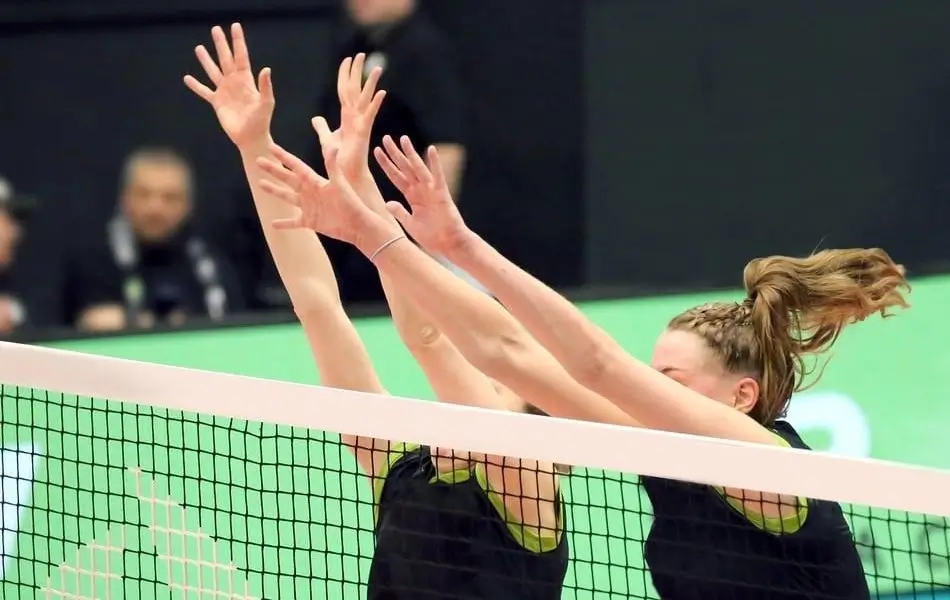Last Updated: February 8, 2024
The middle blocker plays a crucial role in volleyball. Their role is critical in defending against hitters at the net. But on the same note, the dynamics of the position can also suggest middle blockers are excellent in attack.
The middle blocker is a versatile position that requires dedication and skill. Like in any other sport, things change over the years, techniques evolve, and tactics advance.
Here are the key factors to become successful as a middle blocker.
10 Traits for Achieving Success as a Middle Blocker

1. Timing Capabilities
No matter how tall you are or how good you are at jumping and blocking, these skills become useless if you’re not good with timing. You need to time everything, from positioning to jumping. The same rule applies in attacks.
Timing is an aspect most players overlook when training. Sure, it goes with your instinct, but at the same time, you need to be ready for any possible scenario.
2. Speed in Attack
The middle blocker has a primary defensive profile, but attacks are just as important. If defense is based on the opponent hitters, attacks are based on your own team, and that’s when speed becomes a critical consideration.
When it comes to speed, your main focus is on the setter. You need to work on execution but also ensure that coordination is flawless.
3. Communication
The libero is by far the most communicative position on the court, but the middle blocker is not far behind. In this case, it’s not necessarily about telling others this and that, but about paying attention to what others communicate to you.
The better you and your team communicate, the better your game will be, simple as that.
4. Vertical Jump
This is a no-brainer, but also an aspect that’s easily overlooked. Just because you’re one of the tallest players on the team, it doesn’t mean you cannot also be a great jumper. In fact, many of the best jumpers in volleyball were shorter than average.
Training exercises are critical when it comes to your vertical jump. Positioning and knee exercises – all these things matter for an explosive jump. Plyometric exercises are just as useful.
5. Observant Attitude
You’ll have to be an observant character to predict blocks in an effective manner. You can partially do so by analyzing your opponents’ previous games. But at the same time, it pays off assessing their skills and styles while on the court, too.
6. Versatility
Just like you try to observe others and predict their moves, they’ll do the same. When training for a middle blocker, you must try out different techniques and approaches. In other words, you’ll have to adapt to keep your opponents guessing.
7. Height
It’s no surprise why the middle blocker is often one of the tallest players in the team. You’ll have to use your height and long arms to block, but also to surprise opponent blockers if they’re shorter than you. Height is one of the main requirements to be a good middle blocker.
8. Coordination
In volleyball, coordination is one of those things you can train. While your whole team needs to coordinate, you must pay special attention to your setter. These two positions basically run the game, so you need to train together and develop some sort of communication language.
Talking is a common method to coordinate, but you don’t want the opponent to understand what you’re planning. Nodding and small signs are just as common in the process.
In terms of training, you can practice different tempos, different attack techniques, or different fake moves to confuse opponents.
9. Explosiveness
Explosiveness is often more beneficial than your height or perhaps your jumping abilities. For example, out-jumping opponents isn’t always a priority, yet many newbies prioritize it. You don’t really need to jump higher. What’s more important is the actual jumping speed.
You’ll be alright if you can reach over the net rather than going to the highest point. Being explosive when you jump is essential because you have to clear the net as quickly as possible. Even if you do out-jump a hitter, doing it too late makes it useless.
10. No Ball Slapping
Your role is to block, not to smack the ball back. You need to be a wall in front of opponent attacks, simple as that. Try training while keeping hands firm, but make sure they’re not extremely rigid. At the same time, focus on blocking, rather than slapping.
It sounds easy, but your instinct will naturally be to counterattack. You’ll have to focus on keeping it under control.
Recommended: How Middle Blockers Turn Blocks into Attacks
Final Thoughts
In the end, while some of these considerations actually make sense, others are often overlooked. Sometimes, it’s a mindset thing and natural instinct. Other times, it’s poor training.
Either way, it’s imperative to take one thing at a time and train on it separately in order to make new habits and up your game in the long run.
